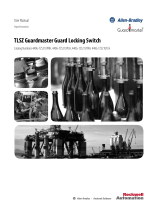Page is loading ...

INTERLOCK SWITCH
100 SERIES
58
1-800-336-4206
www.edwardssignalling.com
Series 100 Interlock Switches
Installation Instructions
Installation
Mounting Instructions
1. Select a mounting location where the switch and actuator can
be installed with their labels reading in the same direction.
2. Mount the switch on the stationary frame of the machine and
the actuator the moveable guard, door, or gate.
Switches Models 125, 126, 128C & 129: Slightly over-drill holes
for easy insertion. The switch and actuator should easily slide
or screw into the predrilled holes – DO NOT force or hammer.
This may damage switch.
3. For best protection against operator defeat, mount with non-
removable screws, bolts, or nuts. (See accessories)
4. The switch and actuator must be mounted so that the
actuator moves in one of the approved directions ( Figure 1 and
Figure 2).
5. Parallel actuation is NOT recommended except for barrel type
switches. An on/off/on double actuation signal may result
when the magnet passes by the switch.
6. When mounting on a hinged gate or door, mount the switch
and actuator at least 6" away from the hinges so a more face
to face approach is achieved.
7. The actuator can be mounted at a 90° rotation.
8. Keep the switch and actuator within the listed sense range
(see specific switch electrical specifications).
9. Mounting on a ferrous (steel) material will reduce the sense
range a minimum of 50%. A 1/4" nonferrous (plastic or
aluminum) spacer installed under the actuator and switch will
restore most of the lost gap.
10. When mounting a metal switch to an ungrounded machine,
connect the ground lead to one of the switch mounting screws.
CAUTION — Particular care must be taken to determine the
actual load of the switch circuit.
1. Surges from coils, motors, contactors, solenoids and
tungsten filaments must be considered.
2. Transient protection, such as back-to-back zener diodes
(Transorb) or an RC network, is recommended for such loads
to ensure that maximum ratings of the switch are not
exceeded.
3. Line capacitance and load capacitance must be considered.
An in-line resistor can be added to limit the inrush current.
4. The resistor can only be added in series with the last wire
just before the load.
5. The voltage drop and the power rating of the resistor must
be considered.
Voltage drop = I • R
Watts = I
2
• R
( I = maximum continuous current of the load)
Surface Mounting Configurations
Perpendicular
Actuation
*
Door
Actuation
Parallel
Actuation
OK
OK Not Recommended
Rotated
Actuation
OK
Actuator Actuator
* Actuation surface
Barrel Switch Mounting Configurations
End-to-End
Parallel
OK
OK
NO
Perpendicular
OK
Figure 1
Figure 2
/

